by Rick Landers
Images: Michael G. Stewart; R. Landers; A. Wechter
 Guitar builder, Abe Wechter, has come a long way since opening his first guitar business in Seattle, Washington, over 30 years ago. During that time, Abe found himself immersed in world-class guitar building, that included spending over a decade with Gibson Guitars as a model-maker and designer. He designed and built handmade guitars for such luminaries as B.B. King; John McLaughlin; Al DiMeola; John Denver; Steve Howe; and Earl Klugh.
Guitar builder, Abe Wechter, has come a long way since opening his first guitar business in Seattle, Washington, over 30 years ago. During that time, Abe found himself immersed in world-class guitar building, that included spending over a decade with Gibson Guitars as a model-maker and designer. He designed and built handmade guitars for such luminaries as B.B. King; John McLaughlin; Al DiMeola; John Denver; Steve Howe; and Earl Klugh.
Wechter spent nine years building Kasha guitars that were collaborative designs of Richard Schneider and Dr. Michael Kasha. Later, he would open his own 6,000 square foot guitar building operation in Paw Paw, Michigan, until the business outgrew the facility. In 2008, he moved Wechter Guitars to its current home in Fort Wayne, Indiana.
Though Abe’s custom-made guitars, like the Wechter USA Custom Traditional, have been his trademark instruments, nine years ago he went offshore and established a deal to have some of his Wechter line of guitars built in China in order to offer more affordable guitars to his growing clientele.
 |
| Wechter USA Custom Traditional. Photo credit: Michael G. Stewart. |
Guitar International met Abe Wechter last year after he’d had a lengthy conversation with a guitar distributor at Summer NAMM 2008 in Nashville, Tennesse. Affable and soft spoken, Abe showed us some of the guitars he had on display, with their unique double Florentine type upper bouts and trademark headstocks. Also parked at his booth were his line of Scheerhorn Model Squareneck Resonators.
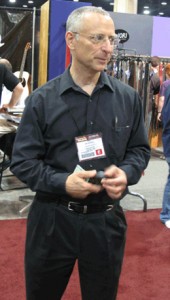 Rick Landers: From the beginning of your guitar building career, how did you initially learn how to build guitars and were there any enlightening moments that helped you move to a higher level of craftsmanship?
Rick Landers: From the beginning of your guitar building career, how did you initially learn how to build guitars and were there any enlightening moments that helped you move to a higher level of craftsmanship?
Abe Wechter: I started building guitars at a small repair shop in Seattle near the University District. Eventually I converted a room of the communal house I was living in into a small workshop and started building and repairing on my own.
After about a year in Seattle I moved to a very remote farmhouse near Morton, Washington and continued to develop my skills. Up to this point I was pretty much entirely self-taught. My big break came when I was accepted as an apprentice by Richard Schneider and moved to Detroit to work in his shop.
He taught me a traditional style of building based on his own apprenticeship in Mexico City with Juan Pimentel, but the guitars he built were very progressive and original in design. His work with Dr. Michael Kasha on instrument design was influential in my early building career.
Rick: Did you get any mentoring or support from others in the business?
Abe: Richard was like a father to me. He inspired me to reach for a standard of excellence that I still work towards every day. He passed away suddenly in 1997, but I keep his photo on my desk and will never forget the years I was fortunate enough to work with him.
Rick: Are you a guitar player? If so, tell us about your guitar playing background and what you do now with that talent.
Abe: I started playing while living in a small cabin on a rock off the coast of Orcas Island in Puget Sound. I’d watch the geese come honking across the Sound at night in front of Mt. Constitution and play simple three-chord progressions on my Yamaha guitar. As time went on I studied classical guitar and for a while I was a fairly decent classical player.
However, the more I got involved in guitar making the less time and interest I seemed to have in playing. I don’t play much anymore, and I think it would be fair to say that CAD has replaced guitar playing for me as a creative hobby.
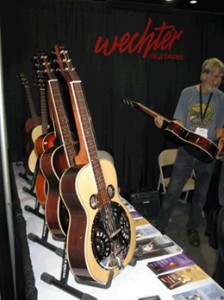 Rick: How significant are the various woods you use in transforming a guitar design to optimize its tone or range of tones?
Rick: How significant are the various woods you use in transforming a guitar design to optimize its tone or range of tones?
Abe: Woods are of course very important. We now buy logs when we can and dry and resaw the wood ourselves. I like to work with domestic woods whenever possible for many reasons. We get to know the properties very well through repetition so we can anticipate the response much more accurately then when we are working with trees that are harvested from different sources. I think we become more sensitive to subtle characteristics of the woods this way. For top wood we have no local woods available so I go to specialty sawmills in the Northwest to select the tops.
Rick: How does the internal configuration of bracing change the sound?
Abe: Bracing is critical to tone but it is a common amateurish pitfall to spend countless hours discussing the virtue of a bracing change and to attribute definite tonal results to a very small sample of actual instruments. My work with Richard Schneider opened my mind to more radical bracing possibilities, but in the end I have developed a much more conservative approach.
I think you have to respect the structural limits of the materials especially given fluctuations of relative humidity and temperature. So in a way I think that inexperienced builders may put too much emphasis on bracing design. It is part of the total equation, but neck angle, finish and setup play equally important roles.
Rick: How did you end up at Gibson and what jobs did you hold during that part of your profession?
Abe: I was hired at Gibson to work with Richard Schneider as his assistant while he developed the Mark Series. I started at Gibson in January of 1975.
In the beginning I was a model maker, attached to the Engineering department. I built prototypes of all the new models and also special instruments for the Artist Relations Department. Eventually I started doing more project management and design for Gibson as well. I had the opportunity to work with many artists but I think I was most impressed when I got a chance to meet and work with B.B. King. He had been a real idol to me since I had seen him perform at local bars on the South Side of Chicago in the late ’60’s, while I was a student at the University of Chicago.
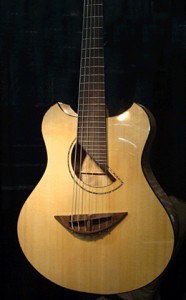 Rick: What were the highlights of working at Gibson and what guitars stand out as the most personally and professionally satisfying that you designed or built?
Rick: What were the highlights of working at Gibson and what guitars stand out as the most personally and professionally satisfying that you designed or built?
The highlight of my work at Gibson was probably my artist relation work for John McLaughlin, and other great musicians I had the opportunity to build for. I also learned a lot about manufacturing technology and drafting.
Rick: Moving from what appears to have been a pretty secure position with Gibson to opening your own business can be a giant leap or an incremental evolution. Please, tell us about the mental hoops and the practical challenges that you had to overcome to start Wechter Guitars.
Abe: It was tough in the beginning, but in way I had no choice. The Gibson company had lost my respect and I just couldn’t see myself working for them anymore. I left Gibson at the end of 1984. I was fortunate that I already had a nice shop and had the skills to build fine guitars, so it was pretty much a matter of building, taking the guitars to players and to shows, coming home and building more.
At this point I was building almost exclusively classical guitars. I think a real turning point for me was when I started changing the classical design into more of a jazz oriented nylon string instrument with a larger body and 14-fret neck. This eventually has led to our current model 9303C the Florentine Cutaway Nylon string. As time went on I developed a nice backlog of orders for the classical nylon strings and the “jazz nylons” as I referred to them at the time.
By the beginning of the ’90’s I was getting very good money for my handmade guitars and had a long backorder list. However many of my customers were collectors who played poorly if at all, and I wanted to get back into the music industry, not be a pet builder for wealthy patrons the rest of my working life. So, I developed the double cutaway Pathmaker design, bought a building and started a manufacturing company. This is when Wechter Guitars became incorporated.
In the beginning we focused on production style building, but now that we also import from China we have moved to a more custom shop environment for our US built guitars.
Rick: What prompted your decision to go offshore and contract for production in China?
Abe: China represents the opportunity for me to participate in the broader guitar market than I could if I built everything in the US. We are working with the finest factories in China to produce great guitars and since we do all the setup and electronics installation in our US shop we can provide professional level quality on very affordable guitars.
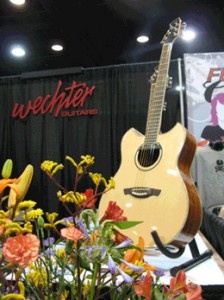 Rick: How do you control quality of the imported guitars?
Rick: How do you control quality of the imported guitars?
Abe: First of all, you should know that I’ve been to North and South China, Taiwan, Korea and Vietnam so many times that they ran out of places to stamp my passport, and I had to send it back to get additional pages put in.
There is no substitute for going over and inspecting and building the relationships that get you through difficult business conversations. In addition we have a Plek Pro to do all our frets, nut and saddle work, so all our guitars, including the imports, receive the finest setup possible.
Finally we have a small retail outlet in the front of our shop for local sales only, to sell our cosmetically blemished guitars, so we never have to compromise the quality we ship to our dealers.
Rick: Do you have a strategy to manage how you grow your business?
Abe: At this point I’d have to say that growth is not a big concern for me, we’re doing fine at our current size. The economy is going through some volatility right now, so I don’t feel it’s the right time to leverage our company out. We want to keep the quality up and maybe increase the number of guitars we are building in our shop.
Rick: There hundreds of guitar builders that are building high standard guitars. What sets Wechter apart from the others in a way that draws new clients?
Abe: Design, attention to detail and value. We certainly don’t have a big advertising budget; I prefer to concentrate on the quality of our guitars and on innovation. Plus we try to meet the highest standard for customer service. This means taking care of our customers anyway we can, going beyond the standard business practice when necessary to put our customers first.
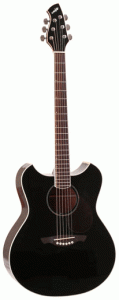 Rick: What’s been your toughest challenge in this business and what are you most proud of as a guitar builder and professional?
Rick: What’s been your toughest challenge in this business and what are you most proud of as a guitar builder and professional?
Abe: The toughest challenge for me was getting out of my comfort zone as an independent builder and starting to talk to people. I used to spend weeks at a time without talking at all, except to my wife. People would ask me, “How do you keep from going crazy?”
My standard answer was “You’re making an assumption…”
The achievement I’m most proud of is that I have had the courage to move out of that comfort zone and have had the opportunity now to innovate and engage in the greater world of guitar making. I never thought that I would have the opportunity to work with the great crew we have at the shop and participate in the guitar industry in the way we do.
Rick: There are different degrees of control and financial security between being a sole proprietor and working for a large company. Any regrets going out on your own?
Abe: None.

Related Link
Wechter Guitars
Michael G. Stewart Imaging Solutions